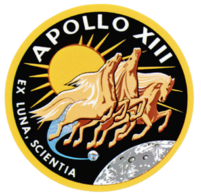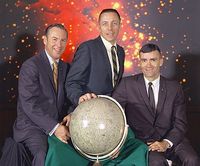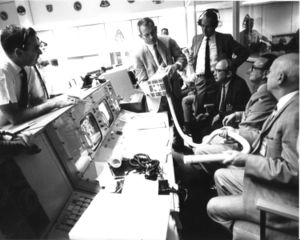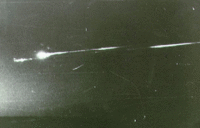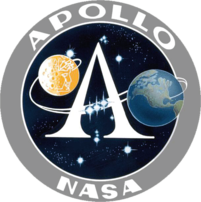Apollo 13
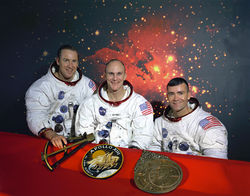
Original crew photo.
Left to right: Lovell, Mattingly, Haise. |
||||||||||||||||||||||||||||||||||||||||||||
Apollo 13 was the third Apollo mission intended to land on the Moon. A mid-mission incident occurred when an oxygen tank rupture severely damaged the spacecraft and forced the lunar landing to be aborted. The flight was commanded by James A. Lovell; with John L. "Jack" Swigert, Command Module pilot; and Fred W. Haise, Lunar Module pilot. Swigert was a late replacement for the original CM pilot Ken Mattingly, who was grounded by the flight surgeon after exposure to German measles.
The mission was launched on April 11, 1970 at 13:13 CST. Two days later, en route to the Moon, a fault in electrical equipment inside one of the Service Module's oxygen tanks produced an explosion which caused the loss of both tanks' oxygen, depriving the Service Module of electrical power. This forced the crew to shut down the Command Module to conserve its batteries and oxygen needed for the last hours of flight, and use the Lunar Module's resources as a "lifeboat" during the return trip to Earth. Despite great hardship caused by limited power, loss of cabin heat, shortage of potable water, and the critical need to jury-rig the carbon dioxide removal system, the crew returned safely to Earth on April 17, and the mission was termed a "successful failure".[3]
Contents |
Crew
Prime and back up crew
By the standard crew rotation in place during the Apollo program, the prime crew for Apollo 13 should have been the backup crew for Apollo 10 with Mercury and Gemini veteran L. Gordon Cooper in command. That crew was composed of
- L. Gordon Cooper, Jr (commander)
- Donn F. Eisele (command module pilot)
- Edgar D. Mitchell (lunar module pilot)
However, Deke Slayton recollected in his memoirs that Cooper and Eisele were never intended to rotate to another mission as both were out of favor with NASA management for various reasons (Cooper for his lax attitude towards training and Eisele for incidents aboard Apollo 7 and an extra-marital affair) and were assigned to the backup crew simply because of a lack of flight-qualified manpower in the Astronaut Office at the time the assignment needed to be made. Cooper, Slayton noted, had a very small chance of receiving the Apollo 13 command if he did an outstanding job with the assignment, which he didn't. Eisele, despite his issues with management, was always intended for future assignment to the Apollo Applications Program (which was eventually cut down to only the Skylab component) and not a lunar mission.[4]
Thus, the original assignment for this flight submitted by Slayton to his superiors was
- Alan B. Shepard, Jr (commander)
- Stuart A. Roosa (command module pilot)
- Edgar D. Mitchell (lunar module pilot)
However, for the first time ever, Slayton's recommendation was rejected by management because they felt that Shepard, who had only recently benefited from experimental surgery to correct an inner ear disorder and had not flown since 1961, needed more time to properly train for a lunar flight. Thus, Lovell's crew, backup for the historic Apollo 11 mission, which had been targeted (by virtue of the rotation) for Apollo 14, was swapped for Shepard's crew.[5] Thus the original crew selection for the mission was as follows:-
Prime crew:
| Position | Astronaut | |
|---|---|---|
| Commander | James A. Lovell, Jr. | |
| Command Module Pilot | Ken Mattingly | |
| Lunar Module Pilot | Fred W. Haise, Jr. | |
Backup crew:
| Position | Astronaut | |
|---|---|---|
| Commander | John W. Young | |
| Command Module Pilot | John L. Swigert | |
| Lunar Module Pilot | Charles M. Duke, Jr | |
Ken Mattingly was originally slated to be the Command Module pilot. Seven days before launch, backup LM pilot Charles Duke contracted German measles from one of his children. This exposed both prime and backup crews, who trained together. Mattingly was found to be the only one of the five who had not had measles as a child and thus not immune. Three days before launch, based on demand of the Flight Surgeon, backup CMP Swigert was moved to the prime crew.[6] Thus the crew for the flight was Lovell, Haise and Swigert.
Crew at launch:
| Position | Astronaut | |
|---|---|---|
| Commander | Jim Lovell Fourth spaceflight |
|
| Command Module Pilot | Jack Swigert First spaceflight |
|
| Lunar Module Pilot | Fred Haise First spaceflight |
|
Mattingly never contracted the measles, and was assigned after the flight as Command Module pilot to Young's crew, which later flew Apollo 16, the fifth mission to land on the moon.
Support crew
- Vance D. Brand
- Jack R. Lousma
- Joseph P. Kerwin
Flight directors
- Gene Kranz (lead)[7] - White Team
- Glynn Lunney[7] - Black Team
- Milt Windler[7] - Maroon Team
- Gerry Griffin[7] - Gold Team
Mission parameters
- Mass: CM 28,945 kg; LM 15,235 kg
- Perigee: 181.5 km
- Apogee: 185.6 km
- Inclination: 33.5°
- Period: 88.07 min
Objective
The Apollo 13 mission was to explore the Fra Mauro formation, or Fra Mauro highlands, named after the 80-kilometer-diameter Fra Mauro crater located within it. It is a widespread, hilly geological (or selenological) area thought to be composed of ejecta from the impact that formed Mare Imbrium.
The next Apollo mission, Apollo 14, eventually made a successful flight to Fra Mauro.
Oxygen tank rupture
- April 14, 1970, 03:07:53 UTC[8] (April 13, 21:07:53 CST) (55:54:53 g.e.t. ground elapsed time)
- 321,860 km (199,995 mi) from Earth
Closest approach to Moon
- April 15, 1970, 00:21:00 UTC
- 254.3 km (158.0 mi) (possibly a record; see Mission notes below)
Cost
The cost of the mission was $4.4 billion.
The launch incident
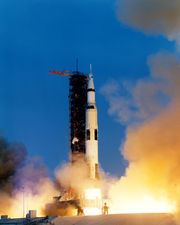
The mission began with a little-known smaller incident: during the second-stage boost, the center (inboard) engine shut down two minutes early. The four outboard engines burned longer to compensate, and the vehicle continued to a successful orbit. The shutdown was determined to be due to dangerous pogo oscillations that might have torn the second stage apart. The engine experienced 68g vibrations at 16 hertz, flexing the thrust frame by 3 inches (76 mm).[9] The engine shutdown was triggered by sensed thrust chamber pressure fluctuations.[10] Smaller pogo oscillations had been seen on previous Titan and Saturn flights (notably Apollo 6), but on Apollo 13 they were amplified by an unexpected interaction with turbopump cavitation.[11] Later missions implemented anti-pogo modifications that had been under development. These included addition of a helium gas reservoir to the center engine liquid oxygen line to dampen pressure oscillations, an automatic cutoff as a backup, and simplification of the propellant valves of all five second-stage engines.
The oxygen tank incident
The explosion
En route to the Moon, approximately 200,000 miles (320,000 km) from Earth, Mission Control asked the crew to turn on the hydrogen and oxygen tank stirring fans, which were designed to destratify the cryogenic contents and increase the accuracy of their quantity readings. Suddenly, the astronauts heard a loud "bang", accompanied by fluctuations in electrical power and firing of the attitude control thrusters. The crew initially thought that a meteoroid might have struck the Lunar Module (LM).
In fact, the number 2 oxygen tank, one of two in the Service Module (SM), had exploded.[12] Damaged Teflon insulation on the wires to the stirring fan inside oxygen tank 2 allowed them to short-circuit and ignite the insulation. The resulting fire rapidly increased pressure beyond its 1,000 pounds per square inch (6.9 MPa) limit and the tank dome failed, filling the fuel cell bay (Sector 4) with rapidly gassifying oxygen and combustion products. It is also possible some combustion occurred of the Mylar/Kapton thermal insulation material used to line the oxygen shelf compartment.[13]
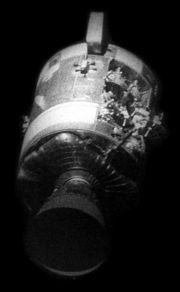
The resulting pressure inside the compartment popped the bolts attaching the Sector 4 outer aluminum skin panel, which as it blew off probably caused minor damage to the nearby high-gain S-band antenna used for translunar communications. Communications and telemetry to Earth were lost for 1.8 seconds, until the system automatically corrected by switching the antenna from narrow-band to wide-band mode.
Mechanical shock forced the oxygen valves closed on the number 1 and number 3 fuel cells, which left them operating for only about three minutes on the oxygen in the feed lines. The shock also either partially ruptured a line from the number 1 oxygen tank, or caused its check or relief valve to leak, causing its contents to leak out into space over the next 130 minutes, entirely depleting the SM's oxygen supply.[13]
Because the fuel cells combined hydrogen and oxygen to generate electricity and water, the remaining fuel cell number 2 finally shut down and left the Command Module (CM) on limited-duration battery power. The crew was forced to shut down the CM completely and to use the LM as a "lifeboat".[14] This had been suggested during an earlier training simulation but had not been considered a likely scenario.[15] Without the LM,[16] the accident would certainly have been fatal.
Crew survival and return journey

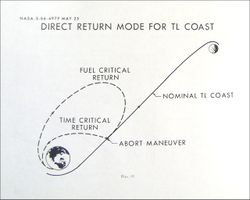
The damage to the Service Module made safe return from a lunar landing impossible, so Lead Flight Director Gene Kranz immediately aborted the mission. The existing abort plans, first drawn up in 1966, were evaluated; the quickest was a Direct Abort trajectory, which required using the Service Module engine to achieve a large change in velocity to essentially reverse the direction of the craft. Though this would get the men home quickest with the least drain on consumables, it was highly impractical for the following reasons:
- It was practical only in an earlier stage of the mission, before the craft entered the Moon's gravitational sphere of influence.
- There was no practical way to get electrical power to fire the engine.
- It was feared the engine might have been damaged in the explosion, preventing it from being fired safely.
For these reasons, Kranz and Flight Director Chris Kraft chose the circumlunar "free return" option, using the Moon's gravity to return the ship to Earth, with an acceleration burn shortly after pericynthion (closest approach to the Moon, "PC+2 burn") to help speed the return. Unfortunately, Apollo 13 had left its initial free return trajectory earlier in the mission, which was required for the planned lunar landing at Fra Mauro. Therefore the first order of business was to re-establish the free return trajectory with a small burn of the LM descent propulsion system. The descent engine was used again for the PC+2 burn. One more descent engine burn was later required for a minor course correction.

Considerable ingenuity under extreme pressure was required from the crew, flight controllers and support personnel for the safe return. The developing drama was shown on television.[17] Because electrical power was severely limited, no more live TV broadcasts were made; TV commentators used models and animated footage as illustrations. Low power levels made even voice communications difficult.
The LM "lifeboat" consumables were intended to sustain two people for only two days, not three people for four days. Oxygen was the least critical consumable because the LM carried enough to repressurize the LM after each surface EVA. Unlike the CSM, which was powered by fuel cells that produced water as a byproduct, the LM was powered by silver-zinc batteries so electrical power, and water (used for equipment cooling as well as drinking) were critical consumables. To keep the LM life support and communication systems operational until re-entry, the LM was powered down to the lowest levels possible.
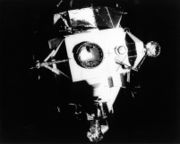
Limited available lithium hydroxide (LiOH) for removing carbon dioxide presented a serious problem. The LM's internal stock of LiOH canisters was not sufficient to support the crew until return, and the remainder was stored in the descent stage, out of reach. The CM had an adequate supply of canisters, but these were incompatible with the LM. Engineers on the ground improvised a way to join the cube-shaped CM canisters to the LM's cylindrical canister-sockets by drawing air through them with a suit return hose. The astronauts called the jury-rigged device "the mailbox."[18]
Another problem to be solved for a safe return was accomplishing a complete power-up from scratch of the completely shut-down Command Module, something never intended to be done in-flight. Flight controller John Aaron, with the support of grounded astronaut Mattingly and many engineers and designers, had to invent a new protocol to do this with the ship's limited power supply and time factor.[19][20] This was complicated by the fact that the reduced power levels in the LM caused internal temperatures to drop considerably. The unpowered CM got so cold that water actually condensed, causing concern that this might damage electrical systems when it was reactivated. This turned out not to be a problem, partly because of the extensive electrical insulation improvements instituted after the Apollo 1 fire.[21]
Re-entry and splashdown
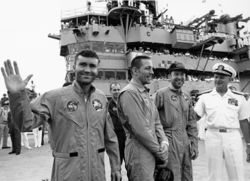
As Apollo 13 neared Earth, the crew first jettisoned the Service Module so pictures could be taken for later analysis. It was then that the crew were surprised to see for the first time that the Sector 4 panel had been blown off. According to the analysts, these pictures also showed the antenna damage and possibly an upward tilt to the fuel cell shelf above the oxygen tank compartment.
Finally, the crew jettisoned the Lunar Module Aquarius, leaving the Command Module Odyssey to begin its lone re-entry through the atmosphere. A normal lunar re-entry was accompanied by four minutes of communications blackout caused by ionization of the air around the Command Module. The possibility of heat shield damage had been feared from the explosion, heightening the tension of the blackout period, which took 33 seconds longer than normal.
However, Odyssey regained radio contact and splashed down safely in the Pacific, , southeast of American Samoa and 6.5 km (4.0 mi) from the recovery ship, USS Iwo Jima. The crew was in good condition except for Haise, who was suffering from a serious urinary tract infection because of insufficient water intake. To avoid altering the trajectory of the spacecraft, the crew had been instructed to temporarily stop urine dumps. A misunderstanding prompted the crew to store all urine for the rest of the flight.[22]
|
Root cause analysis
The tank rupture on Apollo 13 led to a lengthy investigation which, based on detailed manufacturing records and logs, determined the cause of the tank failure to be an unlikely chain of events. Tanks storing cryogens, such as liquid oxygen and liquid hydrogen, require either venting, extremely good insulation, or both, in order to avoid excessive pressure buildup due to vaporization. The Service Module oxygen tanks were so well insulated that they could safely contain supercritical hydrogen and oxygen for years. Each oxygen tank held several hundred pounds of oxygen, which was used for breathable air and the production of electricity and water. However, the construction of the tank made internal inspection of the tank impossible.
The tank contained several components relevant to the accident:
- a quantity sensor;
- a fan to stir the tank contents for more accurate quantity measurements;
- a heater to vaporize liquid oxygen as needed;
- a thermostat to protect the heater;
- a temperature sensor;
- fill and drain valves and piping.
The heater and protection thermostat were originally designed for the command module's 28-volt DC bus. The specifications for the heater and thermostat were later changed to allow a 65-volt ground supply, in order to pressurize the tanks more rapidly. Beechcraft, the tank subcontractor, did not upgrade the thermostat to handle the higher voltage. The temperature sensor could not read above the highest operational temperature of the heater, which was approximately 100 °F (38 °C). This was not normally a problem because the thermostat was designed to open at 80 °F (27 °C).
The oxygen shelf carrying the oxygen tanks was originally installed in the Apollo 10 service module, but was removed to fix a potential electromagnetic interference problem. During removal, the shelf was accidentally dropped about 2 inches (5 cm) because a retaining bolt had not been removed. The tank appeared to be undamaged, but a loosely-fitting filling tube was apparently damaged, and photographs suggested that the close-out cap on the top of the tank may have hit the fuel cell shelf. The report of the Apollo 13 review board considers the probability of tank damage during this incident to be "rather low".[13] After the tank was filled for ground testing, it could not be emptied through the normal drain line. To avoid delaying the mission by replacing the tank, the heater was connected to 65-volt ground power to boil-off the oxygen. Lovell signed off on this procedure. It should have taken a few days at the thermostatic opening temperature of 80 °F (27 °C). However, when the thermostat opened, the 65-volt supply fused its contacts closed and the heater remained powered.
This raised the temperature of the heater to an estimated 1,000 °F (540 °C). A chart recorder on the heater current showed that the heater was not cycling on and off, as it should have been if the thermostat was functioning correctly, but no one noticed it at the time. Because the temperature sensor could not read higher than 100 °F (38 °C), the monitoring equipment did not register the true temperature inside the tank.[23] The gas evaporated in hours rather than days.
The sustained high temperatures melted the Teflon insulation on the fan power supply wires and left them exposed. When the tank was refilled with oxygen, it became a bomb waiting to go off. During the "cryo stir" procedure, fan power passed through the bare wires which apparently shorted, producing sparks and igniting the Teflon. This in turn boiled liquid oxygen faster than the tank vent could remove it.
The other oxygen tank or its piping, located near the failed tank, was damaged, allowing it to leak also. Design fixes included moving the tanks farther apart, and removing the stirring fans. This required adding a third tank, so that no tank would go below half full. An emergency battery was also added to another sector in the service module.

In June 1970, the Cortright Report provided an in-depth analysis of the mission in an extremely detailed five-chapter report with eight appendices. It showed a copy of established NASA procedures for alleviating high pressure in a cryogenic oxygen tank, to include:
- Turning the four tank heaters and fans off,
- Pulling the two heater circuit breakers to open to remove the energy source,
- Performing a 2-minute purge, or directly opening the O2 valve.
.png)
This procedure was designed to prevent hardware failure so that the lunar landing mission could be continued. However, the EECOM Mission Report (on pg E-10) recounts how the master caution and warning alarm had been turned off for a previous low pressure reading on hydrogen tank 2, and so it did not trigger to call attention to the high oxygen pressure reading.
Oxygen tank 2 was not the only pressure vessel that failed during this mission. Prior to the accident, the crew had moved their scheduled entry into the Lunar Module forward by three hours. This was done so that they could get an earlier look at the pressure reading of the supercritical helium (SHe) tank in the LM descent stage, which had been suspect since before launch. After the abort decision, the helium pressure continued to rise and Mission Control predicted the time that the burst disc would rupture. The helium tank burst disc ruptured at 108:54, after the lunar flyby. The expulsion reversed the direction of the passive thermal control (PTC) roll (nicknamed the "barbecue roll").[24]
While the investigation board did recreate the oxygen tank failure, they did not report on any experiments that would show how effective the Cryogenic Malfunctions Procedures were to prevent the system failure by de-energizing the electrical heater and fan circuits. The report, while extremely detailed in many areas, also gives little analysis on the alternative abort options that were available to bring the crew home earlier.
Mission notes
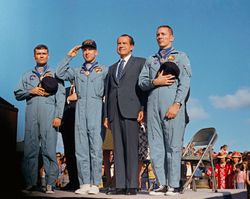
Because Apollo 13 followed the free return trajectory, its altitude over the lunar far side was approximately 100 km (60 mi) greater than the orbital altitude on the remaining Apollo lunar missions. It made the all-time altitude record for human spaceflight. The Guinness Book of Records lists this flight as holding the absolute altitude record for a manned spacecraft, thus Lovell and crew should have received a certificate attesting to this record.
The A7L spacesuit intended to be worn on the lunar surface by Lovell would have been the first to feature red bands on the arms, legs, lunar EVA helmet assembly, and the life-support backpack. This came about because Mission Control personnel watching the video feeds of Apollos 11 and 12 had trouble distinguishing the astronauts while both had their helmet sunshades down. The red bands were a feature for the remaining Apollo flights and are used on the Extravehicular Mobility Units worn by the astronauts of the Space Shuttle program and on the International Space Station (ISS).
The Apollo 13 mission has been called "a successful failure", because the astronauts were brought home safely notwithstanding the failure of the mission.
The crew and the Apollo 13 Mission Operations Team were awarded the Presidential Medal of Freedom for their actions during the mission.
The Cold Cathode Gauge Experiment (CCGE), which was part of the ALSEP on Apollo 13 was never flown again. It was a version of the Cold Cathode Ion Gauge (CCIG) which featured on Apollo 12, Apollo 14, and Apollo 15. The CCGE was designed as a standalone version of the CCIG. On other missions, the CCIG was connected as part of the Suprathermal Ion Detector (SIDE). Because of the aborted landing, this experiment was never actually deployed. Other experiments included on Apollo 13's ALSEP included the Heat Flow Experiment (HFE), the Passive Seismic Experiment (PSE), and the Charged Particle Lunar Environment Experiment (CPLEE).[25]
Plaque and insignia
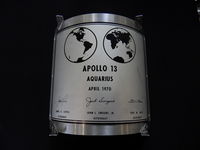
The original lunar plaque on Aquarius bore Mattingly’s name, so the crew was given a replacement with Swigert’s name on it. Aquarius never landed on the moon, however, so Lovell kept the plaque. In his book Lost Moon (later renamed Apollo 13), Lovell states that apart from the Apollo 13 plaque and a couple of other pieces, the only other memento he possesses is a letter from Charles Lindbergh.
The Apollo 13 crew patch featured three flying horses as Apollo's 'chariot' across space. Given Lovell's Navy background, the logo also included the mottoes “Ex luna, scientia” ("From the moon, knowledge"), borrowed from the U.S. Naval Academy's motto, "Ex scientia tridens," ("From knowledge, sea power"). The mission number appeared in Roman numerals as Apollo XIII. It is one of two Apollo insignia—the other being Apollo 11—not to include the names of the crew. (This was fortunate, considering that original crew member Ken Mattingly was replaced two days before the mission began.) It was designed by artist Lumen Winter, who based it on a mural he had done for the St. Regis Hotel in New York. The mural was later purchased by actor Tom Hanks, who portrayed Lovell in the movie Apollo 13, and now is on the wall of a restaurant in Chicago owned by Lovell's son.
"Towing fees"
Grumman Aerospace Corporation, the builder of the Lunar Module, issued an invoice for $312,421.24 to North American Rockwell,[26][27] the builder of the Command Module (CM), for "towing" the crippled ship most of the way to the moon and back. The invoice included a 20% commercial discount, as well as a further 2% discount if North American were to pay in cash. North American declined payment, noting that they had ferried Grumman LMs to the moon on three previous occasions with no such reciprocal charges. The invoice was drawn up by Grumman pilot Sam Greenberg as a gag following Apollo 13's successful splashdown. He had earlier helped with the strategy for re-routing power from the LM to the crippled CM.
Spacecraft location
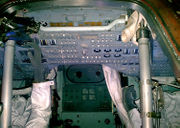
The Command Module shell was formerly at the Musée de l'Air et de l'Espace, in Paris. The interior components were removed during the investigation of the accident and reassembled into BP-1102A, the water egress training module, and were subsequently on display at the Museum of Natural History and Science in Louisville, Kentucky, until 2000. The command module and the internal components were reassembled, and Odyssey is currently on display at the Kansas Cosmosphere and Space Center, Hutchinson, Kansas.
The Lunar Module burned up in Earth's atmosphere on April 17, 1970, having been targeted to enter over the Pacific Ocean to reduce the possibility of contamination from a SNAP 27 radioisotope thermoelectric generator (RTG) on board. (Had the mission proceeded as planned, the RTG would have been used to power the Apollo Lunar Surface Experiment Package, and then remained on the Moon.) The RTG survived re-entry (as designed) and landed in the Tonga Trench. While it will remain radioactive for approximately 2,000 years, it does not appear to be releasing any of its 3.9 kg of radioactive plutonium.[28] A part of the Lunar Module was returned by the astronauts and is on display at the Apollo/Saturn V Center of the Kennedy Space Center Visitor Complex.
Jim Lovell's lunar space suit helmet is located at the Museum of Science and Industry in Chicago.
The Apollo 13 S-IVB with its Instrument Unit was guided to crash onto the lunar surface on April 14, providing a signal for the Apollo 12 Passive Seismic Experiment.
 A recording of the Apollo 13 S-IVB's impact on the lunar surface as detected by the Apollo 12 Passive Seismic Experiment |
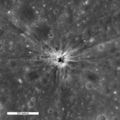 Crater left by the S-IVB's impact |
 Part of the LM, on display at the Apollo/Saturn V Center |
Popular culture
The 1974 movie Houston, We've Got a Problem, while set around the Apollo 13 incident, is a fictional drama about the crises faced by ground personnel, when the emergency disrupts their work schedules and places additional stress on their lives; only a couple of news clips and a narrator's solemn voice deal with the actual problems.
Apollo 13, a film based on Lost Moon, Jim Lovell's and Jeffrey Kluger's book about the event, was released in 1995. It was directed by Ron Howard and starred Tom Hanks as Jim Lovell, Bill Paxton as Fred Haise, Kevin Bacon as Jack Swigert, Ed Harris as flight director Gene Kranz, Kathleen Quinlan as Marilyn Lovell and Gary Sinise as Ken Mattingly. Jim Lovell, Gene Kranz, and other principals have stated that this film depicted the events of the mission with reasonable accuracy, though some dramatic license was taken. Technical inaccuracies have also been noted. The film is among several to misquote Swigert's famous statement, "Houston, we've had a problem".[29] However, the filmmakers purposely changed the line because the original quote made it seem that the problem had already passed.[30] The film was a critical and box office success, and was nominated for several Academy Awards including Best Picture, Best Supporting Actor (Harris) and Best Supporting Actress (Quinlan). The film engendered new interest in the history of the Apollo program and American space flight in general.
Portions of the events surrounding the Apollo 13 mission are dramatized in episode "We Interrupt This Program" of the 1998 miniseries From the Earth to the Moon, co-produced by Ron Howard and Tom Hanks. The story is presented from the perspective of television reporters competing for coverage of the mission.
In 2008, an interactive theatrical show titled APOLLO 13: Mission Control[31] premiered at BATS Theatre in Wellington, New Zealand.[32] The production faithfully recreated the mission control consoles and audience members became part of the storyline. The show also featured a 'guest' astronaut each night - a member of the public who suited up and amongst other duties, stirred the oxygen tanks and said the line "Houston, we've had a problem". This 'replacement' astronaut was a nod to Jack Swigert, who replaced Ken Mattingly shortly before the actual launch in 1970. The production toured to other cities in New Zealand in 2009 and an Australian tour is scheduled for 2010-2011.
See also
|
|
Notes
- ↑ Richard W. Orloff. "Apollo by the Numbers: A Statistical Reference (SP-4029)". NASA. http://history.nasa.gov/SP-4029/Apollo_00g_Table_of_Contents.htm.
- ↑ Lunar flyby (pericynthion) executed April 15, 1970
00:21:00 UTC at 254.3 km above lunar surface. - ↑ Apollo 13 - A Successful Failure
- ↑ Donald K. Slayton, "Deke!" (New York: Forge, 1994), 236
- ↑ Donald K. Slayton, "Deke!" (New York: Forge, 1994), 237
- ↑ "Astronaut Bio: John L. Swigert". NASA. January 1983. http://www.jsc.nasa.gov/Bios/htmlbios/swigert-jl.html. Retrieved August 21, 2009.
- ↑ 7.0 7.1 7.2 7.3 Apollo 13 Mission Operations Report
- ↑ Apollo 13 Timeline
- ↑ Apollo 14 Launch Operations (comments on Apollo 13 pogo), Moonport: A History of Apollo Launch Facilities and Operations, NASA
- ↑ Pogo, Jim Fenwick, Threshold - Pratt & Whitney Rocketdyne’s engineering journal of power technology, Spring 1992
- ↑ Mitigating Pogo on Liquid-Fueled Rockets, Aerospace Corporation Crosslink magazine, Winter 2004 edition
- ↑ Note that NASA's official report (REPORT OF APOLLO 13 REVIEW BOARD) does not itself use the word "explosion" in describing the tank rupture. Rupture disks and other safety measures were present to prevent a catastrophic explosion, and analysis of pressure readings and subsequent ground-testing determined that these safety measures worked as designed. See findings 26 and 27 on page 195 (5-22) of the NASA report.
- ↑ 13.0 13.1 13.2 Cortright, Edgar (June 15, 1970), Report of the Apollo 13 Review Board, http://ntrs.nasa.gov/archive/nasa/casi.ntrs.nasa.gov/19700076776_1970076776.pdf
- ↑ "Apollo 13 Command and Service Module CSM". NASA. http://nssdc.gsfc.nasa.gov/nmc/masterCatalog.do?sc=1970-029A. Retrieved October 31, 2009.
- ↑ Lovell, Jim, and Jeffrey Kluger. Apollo 13. Boston: Houghton Mifflin, 2000. 83-87
- ↑ "Apollo 13 Lunar Module ALSEP". NASA. http://nssdc.gsfc.nasa.gov/nmc/masterCatalog.do?sc=1970-029C. Retrieved October 31, 2009.
- ↑ "Space Program and Television". The Museum of Broadcast Communication. http://www.museum.tv/eotvsection.php?entrycode=spaceprogram. Retrieved October 30, 2009.
- ↑ "Interior View of the Apollo 13 Lunar Module and the "Mailbox"". January 16, 2007. http://grin.hq.nasa.gov/ABSTRACTS/GPN-2002-000056.html.
- ↑ http://www.digitallard.com/moviereview/155/
- ↑ http://www.eetimes.com/conf/esc/showArticle.jhtml?articleID=215900589&kc=2444&printable=true&printable=true
- ↑ ttp://www.nasa.gov/mission_pages/constellation/main/A13_panel.html
- ↑ Account of Apollo 13 by James Lovell, NASA website
- ↑ The Apollo 13 Accident
- ↑ LM Control Officer (Control) Apollo 13 Post-Mission Report, page H-9
- ↑ Apollo Lunar Surface Experiment Package (ALSEP)
- ↑ Invoice from Grumman Aerospace for towing the North American built CM
- ↑ Spokane Daily Chronicle April 18 1970 "Tongue-In-Cheek-Bill Asks Space Tow Fee" from Google News
- ↑ "General Safety Considerations" (pdf lecture notes). Fusion Technology Institute, University of Wisconsin–Madison. Spring 2000. http://fti.neep.wisc.edu/neep602/SPRING00/lecture39.pdf.
- ↑ [|Eric Jones]; Test Division - Apollo Spacecraft Program Office (1970-04). "Apollo 13 Technical Air-to-Ground Voice Transcription" (PDF). NASA. p. 160. http://www.hq.nasa.gov/alsj/a13/AS13_TEC.PDF. Retrieved October 4, 2007. "Houston, we've had a problem."
- ↑ "IMDb: Apollo 13 trivia". http://www.imdb.com/title/tt0112384/trivia. Retrieved May 23, 2009.
- ↑ Official page of the APOLLO 13 production
- ↑ Theatreview media release and subsequent reviews of the BATS Theatre production of APOLLO 13: Mission Control
Further reading
- Lovell, Jim; Kluger, Jeffrey (1994). Lost Moon: The Perilous Voyage of Apollo 13. Houghton Mifflin. ISBN 0-395-67029-2.
- Lattimer, Dick (1985). All We Did was Fly to the Moon. Whispering Eagle Press. ISBN 0-9611228-0-3.
External links
- NASA Apollo 13 press kit - Apr 2, 1970
- Apollo 13 entry in Encyclopedia Astronautica
- Apollo 13 Original reports from The Times
- Apollo 13: NASA's Finest Hour - slideshow by Life magazine
- NASA NSSDC Master Catalog
- APOLLO BY THE NUMBERS: A Statistical Reference by Richard W. Orloff (NASA)
- The Apollo Spacecraft: A Chronology
- Apollo Program Summary Report
- Apollo 13 Characteristics – SP-4012 NASA HISTORICAL DATA BOOK
- Original Apollo 13 Lunar Exploration and Photography Summary Plan (PDF), February 1970
- Apollo 13 Spacecraft Incident Investigation, (PDF) NASA June 1970
- Report of Apollo 13 Review Board, (PDF) NASA June 1970
- Apollo 13 Technical Air-to-Ground Voice Transcription, April 1970, 765 pages (PDF, 20.4 MB)
- Apollo 13, We Have a Solution: Rather than hurried improvisation, saving the crew of Apollo 13 took years of preparation
- Houston, We've Had a Problem Audio of the Apollo 13 mission during its first moments of trouble
- NASA film on the Apollo 13 mission, downloadable from archive.org (The Internet Archive)
- Summary of mission, NASA website
- Excerpts from the Apollo 13 Transcript
- "Man, Moment, Machine" Apollo 13: Triumph on the Dark Side a 2006 documentary on The History Channel
- Apollo 13 with rare NASA photos, video clips and Jim Lovell's book on the mission
- APOLLO 13: Mission Control theatrical production website, with listings, photos and video clips of the production
|
||||||||||||||||||||||||||
